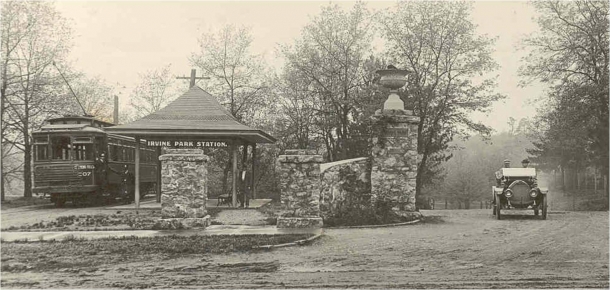The Chippewa Valley Electric Railway
The Chippewa Valley Electric Railway connected Eau Claire, WI and Chippewa Falls, WI, both of which are located along the Chippewa River. The interurban was just over 11 miles in length. (Right of way)
The CVRR largely paralleled two other rail lines, the Milwaukee Road and the Chicago & North Western, of which the C&NW trackage has also been abandoned, albeit much later, and much of that right of way has been converted into the Chippewa River State Trail.
 |
| Irvine Park Station on the CVRR. Image: Chippewa County |
The following history of the interurban comes from History of Eau Claire County Wisconsin, 1914, Past and Present:
"The Eau Claire Street Railway Company was organized and began running cars in 1879. These were horse cars, but after a time mules were also used. The road ran from Shawtown to the Omaha depot and followed the same streets it occupies today, except for a few months, when the present bridge over the Chippewa river was being constructed, when it continued up the west side to Madison street and crossed the Madison street bridge. Also for a time it ran up Galloway street on the north side instead of Madison street, as it does today. J. R. Harrigan was the first superintendent and did much to keep up the efficiency of the road. One winter, in the early eighties, when the snow prevented the use of wheels, he ran sleighs over the Third ward line to keep up the service. He is still engaged in railway work. He was succeeded by Mr. Lawrence, the present efficient superintendent. In 1887 the electric system was installed under the old Sprague company. It was one of the pioneer electric railways in the United States, only three or four antedating it. In 1897 the road was purchased by Arthur E. Appleyard, and, on March 1, 1898, the Chippewa Valley Electric Railway Company was organized with a capital of $400,000, which was increased to $600,000. That company built the road to Chippewa Falls. In October, 1905, the Chippewa Valley Electric Railway Company and the Eau Claire Light & Power Company were purchased by O. H. Ingram and his associates. The latter company came into existence in 1897.
Owing to the development of business the Chippewa Valley Railway Light and Power Company was organized in 1907 with a capital stock of one million dollars and a bond issue of two millions. They purchased the water power at Cedar Falls from the Wisconsin Power Company in 1907, and in 1909 the line was constructed from Menomonie to Eau Claire. Later it was extended to Lake City and Wabasha. In 1910 a fifty-foot concrete dame was built at Cedar Falls, having 14,000 horsepower. In February, 1910, the capital stock of the company was increased to two million dollars. In 1911 the water works, electric plant and gas works at Cedar Falls were purchased, and in July of that year the electric lighting plant at Menomonie was bought. In that year also the transmission line to Altoona was constructed and sites for a lighting plant were purchased on the Chippewa river. Cars began running to Altoona in 1914. In 1913 the company secured the Spring Valley & Ellsworth lighting plant and in 1914 the Elmwood lighting plant was purchased.
In June, 1914, the Chippewa Valley Railway, Light & Power Company was absorbed by the Wisconsin-Minnesota Light & Power Company. This company has a capital of five million preferred stock and five million common stock, with an authorized bonded debt of twenty millions. Mr. Albert E. Pierce is vice-president and general manager of the railroad system under the Wisconsin-Minnesota Company."
Like many of the interurban lines, in an attempt to drum up traffic, the company created a park, namely Midway Park in Eau Claire in 1895. It was renamed to Electric Park in 1910. According to Dewitz Photography, the park "included a band shell, amusement park complete with rides, a canopied Railway Waiting Shelter, dance pavilion, and ball park. In its heyday, the park was known to have dances, moving pictures, and fishing. Electric Park was situated where the Eau Claire Press building is now sits."
 |
| Chippewa Valley Electric Railroad Car 202 in 1903. |
Only one piece of physical infrastructure from the interurban exists today, a pavilion located across from the Northern Wisconsin Fairgrounds.
Before it was replaced with the Phoenix Park Pedestrian Bridge, the Grand Ave Bridge in Eau Claire had remnants of the tracks as far as the late 1970's, if not longer.
 |
| "Street Railway Tracks of CVRL&P Company in Grand Ave Bridge" 1977. FRRandP photo collection. |
Many places randomly dig up their streetcar tracks decades after service ran, however, as often they were simply paved over, which is the case here, as in 1926, the interurban folded. The Eau Claire Leader described the last day as follows, "It was on August 7, 1926 that the old iron horse creaked out of its barn on Menomonie street, rocked over town to Barstow Street, puffed up the Madison Street hill to Omaha Street, swung north on Starr Avenue to begin its 11-mile trek to Chippewa Falls, a journey that ended at the loop in Irvine Park.".



Comments
Post a Comment